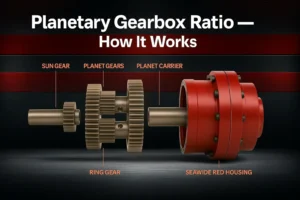Planetary Gearbox Ratios Explained — Boost Efficiency and Torque in One System
Introduction
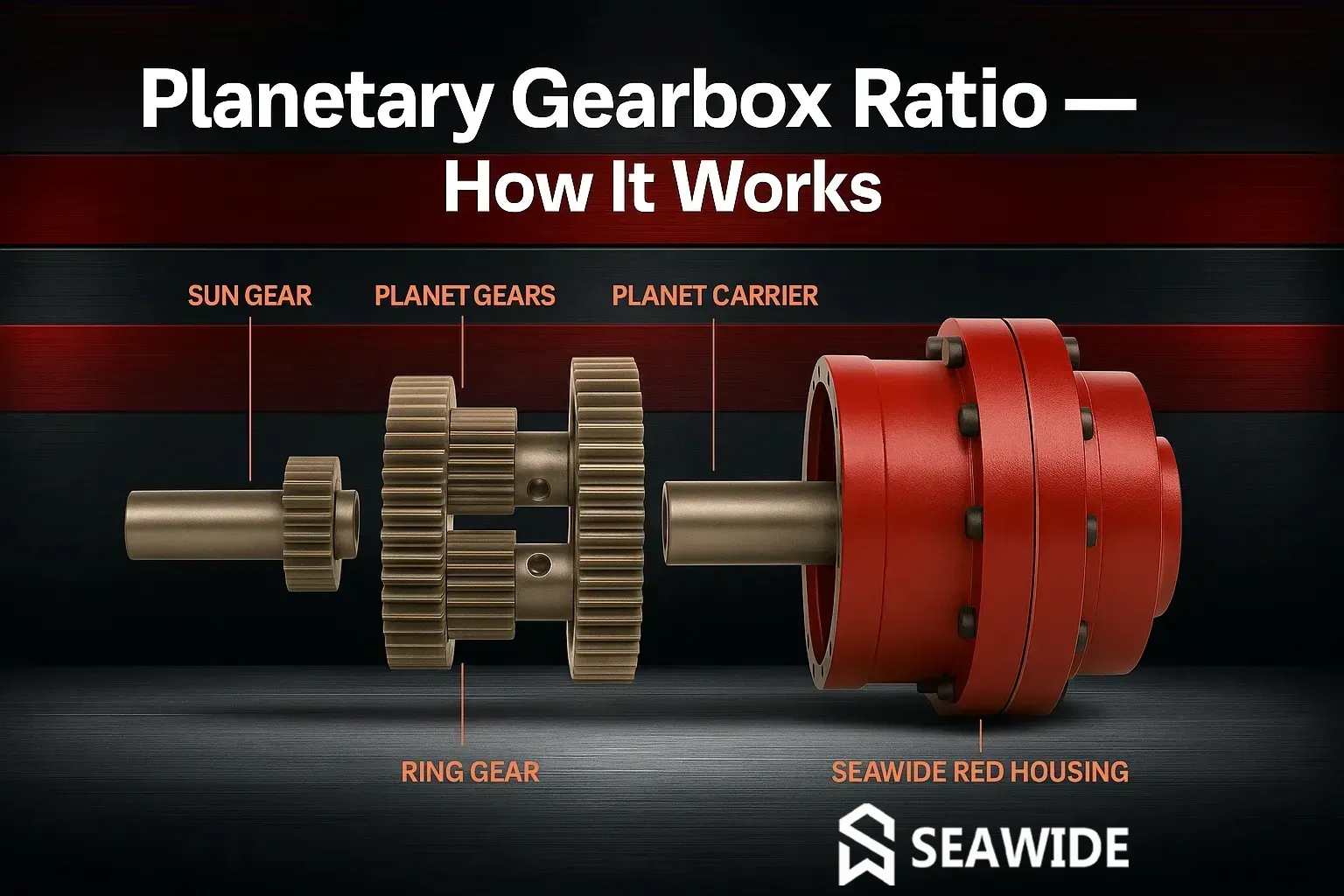
Industrial gearboxes are the silent force behind much of modern industry. They convert motor power into the desired torque and speed required by various machines, ensuring reliability, precision, and energy efficiency. Among all gearbox types, planetary gearboxes — also known as sun and planetary gear reducers — stand out due to their compact design and superior torque density. They are ubiquitous in heavy-duty applications where performance, durability, and efficiency are critical. From steel plants to wind turbines, planetary gear systems deliver optimized motion and power transmission that other gearbox architectures often struggle to match.
In industrial engineering, planetary gearbox ratios are a crucial parameter. They determine how speed and torque are balanced inside the system, influencing the mechanical advantage and performance output. Understanding these ratios helps engineers design machinery that maximizes operational efficiency while preserving material integrity and mechanical precision.
This article explores the design, application, and advantages of planetary gearboxes, and provides technical insights into how gear ratios work to enhance industrial performance. It is structured as a pillar page to support content clusters related to industrial gearbox selection and promote Seawide Gear as a premium supplier of high-torque planetary gear solutions.
Click here to view our planetary gearbox products and their technical information.
Technical Fundamentals of Planetary Gearboxes
Design and Components
A planetary gearbox derives its name from its unique gear arrangement — one resembling a miniature solar system. It consists of:
- Sun Gear: The central gear connected to the input shaft. This gear drives the system and defines the achievable ratio in a single stage.
- Planet Gears: Multiple gears (usually 3–4) revolving around the sun gear at equal spacing, distributing load evenly.
- Planet Carrier: A rigid component holding the axes of all planet gears. It acts as the input or output element depending on configuration.
- Ring Gear (Annulus): The outer gear with internal teeth that mesh with the planet gears. Typically stationary for reduction applications, but can rotate for special configurations.
When power enters through the sun gear, torque is distributed among the planet gears rotating inside the ring gear. This simultaneous power transfer provides high torque density, coaxial output, and compact geometry, ideal for constrained installations.
Click here to view our planetary gearbox products and their technical information.
Working Principle and Ratio Derivation
The advantage of a planetary system lies in multi‑path load sharing — several meshes share torque simultaneously. The result is:
- Higher torque capacity
- Lower noise and vibration
- Increased reliability and service life
Gear Ratio (i):
For a standard reduction (ring gear fixed, sun gear input, carrier output):
Gear Ratio (i) = Output Speed / Input Speed = 1 + (Zr / Zs)
Where:
- Zr = Number of teeth on the ring gear
- Zs = Number of teeth on the sun gear
- i > 1 indicates reduction
Example:
If the sun gear has 30 teeth (Zs = 30) and the ring gear has 120 teeth (Zr = 120):
i = 1 + (120 / 30)
i = 1 + 4 = 5
→ Reduction ratio = 5:1
If the motor input speed = 1000 RPM, then:
Output speed = 1000 ÷ 5 = 200 RPM
Output torque ≈ 5 × input torque (minus small efficiency losses).
For multiple stages:
Total Ratio (Itotal) = i1 × i2 × i3 × ...
Planetary systems using 3–4 stages can easily reach ratios from 1:100 up to 1:1000 or higher — perfect for applications requiring extreme torque at low speeds.
Click here to view our planetary gearbox products and their technical information.
Comparison with Other Gearbox Types
| Feature | Planetary Gearbox | Helical Gearbox (Parallel Shaft) | Worm Gearbox |
|---|---|---|---|
| Efficiency (Single Stage) | 90–98% | 90–95% | 60–85% |
| Torque Density | Very High | Medium | Low–Medium |
| Compactness & Coaxiality | Excellent | Moderate | Poor |
| Backlash (Precision) | Low | Moderate | High |
| Energy Loss (Heat) | Minimal | Moderate | High |
| Load Distribution | Multi‑path, balanced | Single path | Sliding contact |
Planetary gearboxes clearly outperform others when torque density, compactness, and efficiency are key design goals.
Industrial Applications of Planetary Gearboxes
Steel and Metal Processing
- Rolling mills: Generate massive torque for shaping steel billets.
- Slitting and cutting lines: Provide precision motion synchronization.
- Continuous casting: Handle varying loads and thermal stresses reliably.
Cement and Mining
- Conveyors and hoists: Deliver high starting torque for long belt drives.
- Crushers and ball mills: Operate under shock loads and dusty conditions with sealed housings.
Petrochemical Industry
- High‑pressure pumps: Step down high‑speed motors to precise speeds.
- Mixers and extruders: Deliver consistent torque critical for polymer production.
Marine & Offshore
- Winches: Compact high‑torque drives for towing and anchoring.
- Thruster systems: Control propulsion reliably in corrosive environments.
Renewable Energy (Wind Turbines)
- Nacelle low‑speed stages: Handle fluctuating torque while maintaining efficiency to maximize energy output.
Automation & Robotics
- Servo actuators & robotic arms: Low backlash ensures precise positioning.
- CNC machinery: Maintains tool accuracy under high loads.
Advantages & Performance Features Planetary Gearbox Ratios
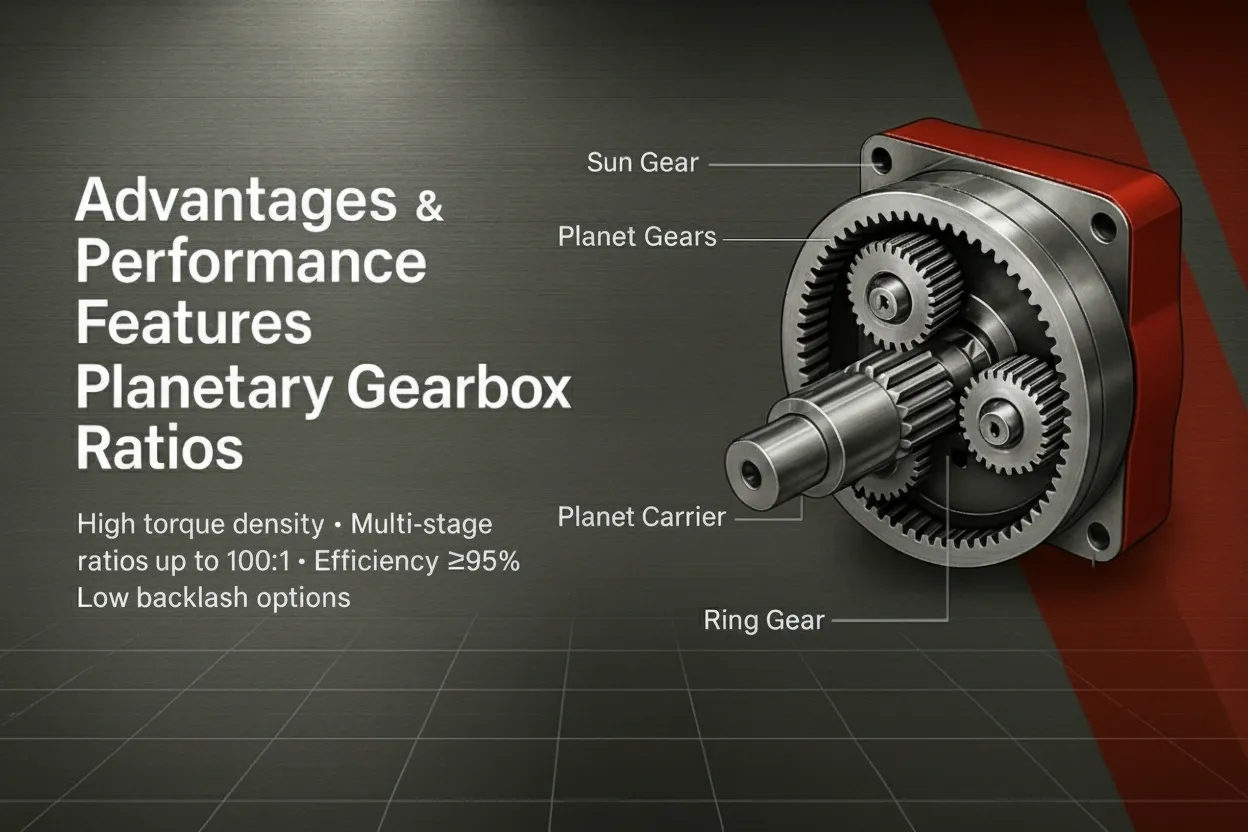
1. High Torque Density
Multiple planet gears share load equally. For a given torque, the gearbox size and weight are significantly reduced compared to other types.
2. Exceptional Efficiency
Predominantly rolling contact means minimal sliding friction. Each stage typically achieves over 95% efficiency, reducing heat and energy waste.
3. Reliability and Longevity
Lower stress per tooth and hardened steel materials (carburized or nitrided) extend operational life well beyond 20,000 hours.
4. Compact Design
Coaxial input/output saves space, allowing direct motor integration and easy installation in confined machinery layouts.
5. Modular Ratios
Flexible stage combinations enable custom reductions: e.g., 1:10, 1:67.5, 1:125 — without over‑sizing the system.
6. Low Backlash
Precision machining under AGMA class ensures tight angular tolerances. Essential for robotics, printing, and automation.
7. Energy‑Efficient Power Transmission
Reduced internal friction saves long‑term energy cost and contributes to sustainability targets.
Click here to view our planetary gearbox products and their technical information.
Competitive Landscape and Seawide’s Advantages
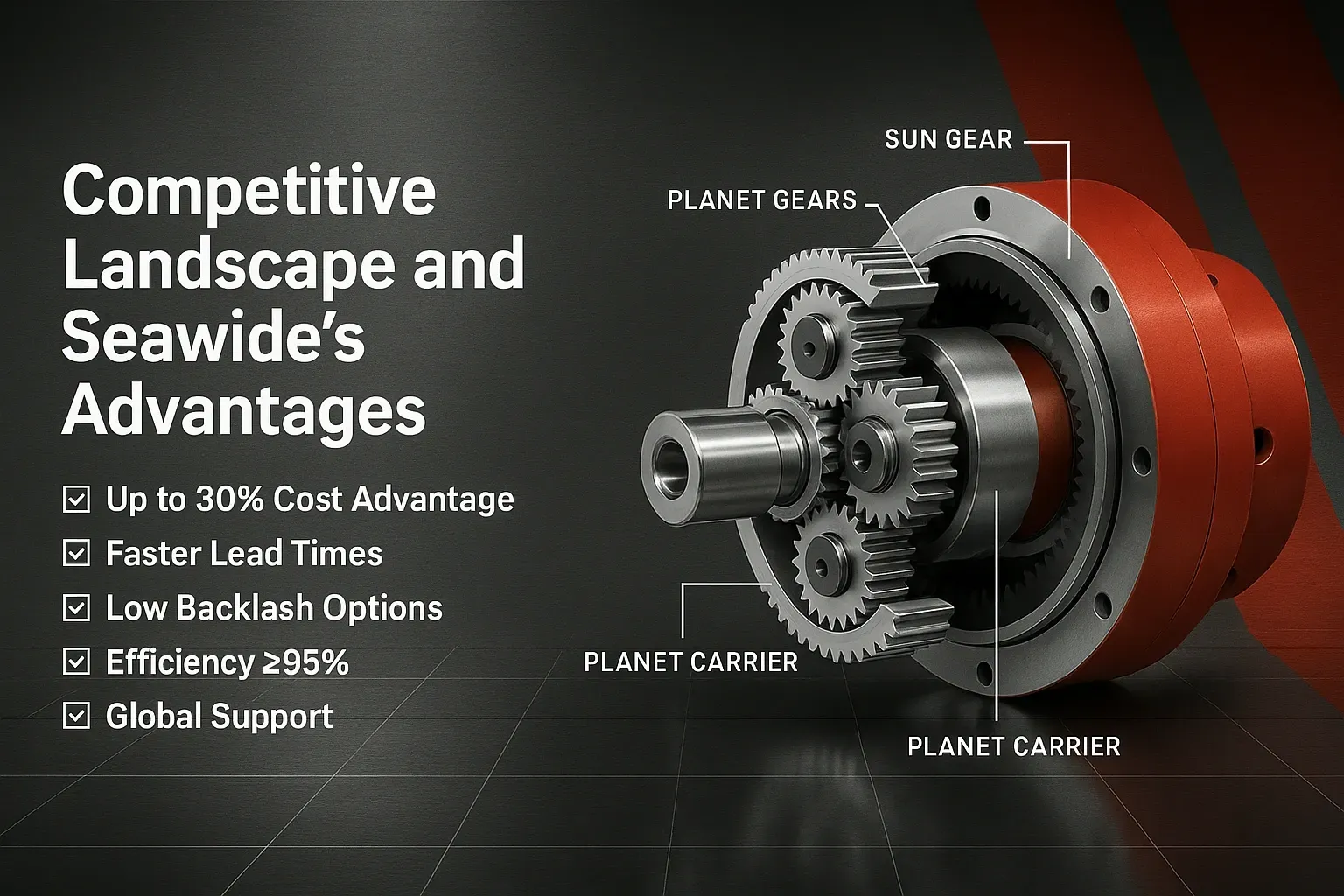
Industry leaders like Reggiana Riduttori, Bonfiglioli, Rossi, and Brevini set high performance benchmarks. Seawide positions itself directly among them by combining premium engineering with cost-efficiency.
Seawide Competitive Strengths
- 30% Cost Advantage: Achieved through lean manufacturing and scalable component standardization.
- ISO 9001 & AGMA Compliance: Guarantees global quality and precision standards.
- Advanced Engineering Integration: CAD/CAM and FEA optimization for torque path efficiency.
- Customization Flexibility: Mounting, shafts, and lubrication tailored to operational specifics.
- Responsive After‑Sales Support: Dedicated engineering and fast global logistics for minimized downtime.
Result:
Seawide delivers the durability and torque performance of top-tier brands at a significantly lower total cost of ownership.
Selecting the Right Planetary Gearbox — Engineering Guide
1. Define Load and Service Factor
Determine required output torque (Tout):
Required Torque = Tload × SF
Where SF = Service Factor, accounting for duty cycle and shock load conditions.
2. Consider Duty Type and Environment
- Continuous Duty (S1): Prioritize thermal management and lubrication control.
- Intermittent or Shock Loads: Larger bearings and stronger gear modules minimize wear.
- Corrosive Environments: Use stainless or coated materials.
3. Torque and Speed Ratio Calculation
Based on rotational speeds:
Gear Ratio (i) = Input Speed / Output Speed
Avoid exceeding ~10:1 per stage for optimal efficiency. Stack multiple stages as required.
4. Efficiency and Thermal Check
Heat generated:
Heat (Q) = Tin × ωin × (1 - η)
Where:
- Tin = input torque
- ωin = input angular speed
- η = efficiency
Ensure adequate cooling and lubrication to maintain temperature limits.
5. Motor and Mounting Compatibility
Match flange type, shaft connection, and alignment accuracy to motor specs (IEC, NEMA, or custom).
6. Maintenance Considerations
Check lubrication method (grease/oil), replacement intervals, and filter accessibility. Premium Seawide units use long-life synthetic lubricants and oversized bearings.
7. Compliance Standards
Planetary gearboxes from Seawide meet or exceed:
- ISO 9001 (Quality Management System)
- AGMA (Gear geometry, stress, and material standards)
- CE Marking (European conformity)
Click here to view our planetary gearbox products and their technical information.
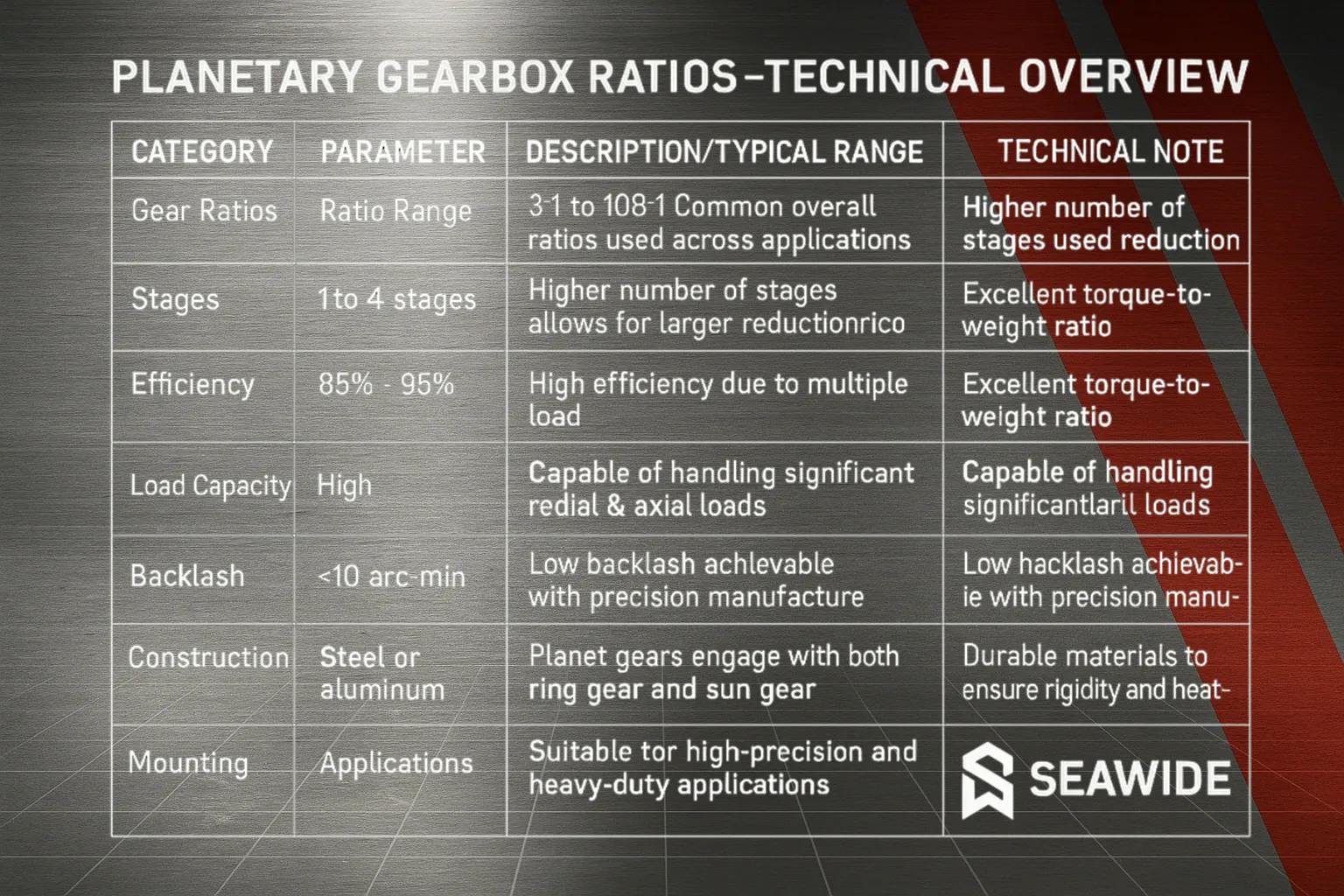
About Seawide Gear
Engineering Precision, Delivered Globally
Seawide Gear is a specialized manufacturer of high‑torque planetary gearboxes. Its mission: combine advanced material science with mechanical precision to deliver long‑life industrial motion solutions.
Manufacturing Excellence
- ISO 9001 Certified Production: Full traceability and process quality.
- AGMA Standard Gearing: Precision machining ensures low vibration and high load capability.
- Automated Validation Testing: Every gearbox tested for torque, vibration, and efficiency.
Customization and Service
- Bespoke Design: FEA‑optimised housings for specific loads.
- Rapid Prototyping: Fast adaptation for ratio or mount modifications.
- Global Logistics: Pre‑stocked sub‑components for fast delivery.


